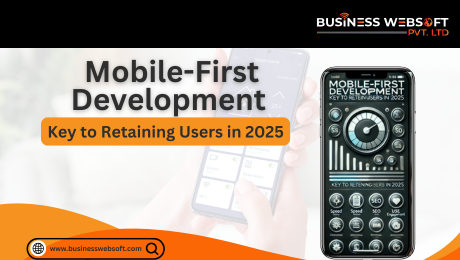With the rapid evolution of the digital world, mobile phones have emerged as the most crucial gateway to the internet. As of 2025, more than 70% of web traffic comes from mobile phones, and thus, mobile-first development is crucial for companies that want to retain users and increase engagement.
With consumer expectations constantly evolving, a seamless and responsive mobile experience can significantly impact customer satisfaction and retention. In this blog, we’ll explore why mobile-first development is crucial in 2025, its benefits, and strategies to create mobile-optimized experiences that keep users coming back.
Why Mobile-First Development is Essential in 2025
Mobile-first development involves designing and building a website or app for handheld devices before scaling it up for bigger screens. This approach guarantees a fast, intuitive, and engaging mobile experience—all of which are key to keeping people around.
Here’s why mobile-first development has become a necessity:
Increasing Mobile Usage
More than 6.5 billion smartphone users worldwide expect fast, mobile-friendly websites and apps. Neglecting mobile users may lead to missed traffic, inferior engagement, and reduced conversions.
Google’s Mobile-First Indexing
Google now indexes and ranks websites based on the mobile version first. Inefficient performance on the mobile side can cause a fall in the rankings of search engines and a subsequent decrease in visibility.
Shorter Attention Spans
⏳ Today’s users anticipate websites and apps to load within 3 seconds. Mobile-first designs prioritize speed so users don’t leave your platform in frustration.
Improved User Experience (UX)
Mobile-first development prioritizes ease of navigation, concise content, and rapid loading times — enhancing user satisfaction and loyalty.
Increased Conversion Rates
A responsive mobile experience drives users to engage with content, subscribe to services, or purchase products — growing the business.
Key Advantages of Mobile-First Development
Prioritizing mobile-first development offers businesses multiple benefits:
✅ Enhanced Performance: Optimized images, low code, and quicker loading time guarantee a slick experience on the mobile platform.
✅ Search Engine Rankings Improved: Google favors mobile-supporting websites with better organic search visibility.
✅ Increased Engagement: Simple interfaces and easy-to-use designs engage users, lowering bounce rates.
✅ Increased Reach: With enhanced accessibility, your site can be accessed by more people, particularly in areas where mobile phones are the primary source of internet access.
✅ More Conversions: An easy-to-use mobile design simplifies the path from browsing to purchase, enhancing conversion rates.
Best Practices for Mobile-First Development in 2025
To get the most out of mobile-first development, use these best practices:
1.Prioritize Responsive Design
Utilize flexible grids, fluid layouts, and media queries to make your website responsive to different screen sizes.
2.Focus on Speed Optimization
Compress images
Minimize JavaScript and CSS
Utilize lazy loading for media content
3. Embrace Minimalist Design
Simple layouts, clear call-to-action (CTA) buttons, and short content enhance navigation and engagement.
4. Use Progressive Web Apps
PWAs deliver app-like experiences directly through a browser, with improved performance and offline availability.
5. Test Across Devices
Test your website or app on multiple mobile devices periodically to detect performance issues, broken features, or design discrepancies.
6. Implement Voice Search Optimization
As voice assistants have become increasingly popular, voice search optimization for your platform guarantees enhanced search visibility and user interaction.
Trends Driving Mobile-First Development in 2025
As tech evolves, new trends are informing mobile-first designs:
AI-Powered Personalization: Offer personalized experiences through AI-driven recommendations and dynamic content.
5G Integration: Improved connectivity will provide richer media, faster loads, and seamless app usability.
Gesture-Based Navigation: The latest interfaces support swipes, taps, and gestures to enhance usability.
Enhanced Security Protocols: Adopting biometric logins and multi-factor authentication guarantees improved user protection.
Conclusion
In 2025, mobile development is no longer a nicety — it’s a survival strategy for companies that wish to thrive in the digital world. Focusing on mobile performance, designing for small screens, and loading quickly will keep users around and increase engagement.
By adopting mobile-first development practices now, companies can stay ahead of the competition in the competitive market and provide experiences that keep customers coming back.
Are you ready to tap into the potential of mobile-first design for your business? Let’s create experiences that engage and convert!
